[English] 日本語
 Yorodumi
Yorodumi- PDB-7ay2: Crystal structure of truncated USP1-UAF1 reacted with ubiquitin-prg -
+ Open data
Open data
- Basic information
Basic information
| Entry | Database: PDB / ID: 7ay2 | ||||||||||||
|---|---|---|---|---|---|---|---|---|---|---|---|---|---|
| Title | Crystal structure of truncated USP1-UAF1 reacted with ubiquitin-prg | ||||||||||||
 Components Components |
| ||||||||||||
 Keywords Keywords | HYDROLASE / deubiquitination / specificity / DNA repair / Fanconi Anemia | ||||||||||||
| Function / homology |  Function and homology information Function and homology informationregulation of protein monoubiquitination / positive regulation of error-prone translesion synthesis / Signaling by cytosolic PDGFRA and PDGFRB fusion proteins / monoubiquitinated protein deubiquitination / deubiquitinase activator activity / hypothalamus gonadotrophin-releasing hormone neuron development / female meiosis I / positive regulation of protein monoubiquitination / fat pad development / skeletal system morphogenesis ...regulation of protein monoubiquitination / positive regulation of error-prone translesion synthesis / Signaling by cytosolic PDGFRA and PDGFRB fusion proteins / monoubiquitinated protein deubiquitination / deubiquitinase activator activity / hypothalamus gonadotrophin-releasing hormone neuron development / female meiosis I / positive regulation of protein monoubiquitination / fat pad development / skeletal system morphogenesis / mitochondrion transport along microtubule / skin development / female gonad development / seminiferous tubule development / male meiosis I / homeostasis of number of cells / positive regulation of intrinsic apoptotic signaling pathway by p53 class mediator / protein deubiquitination / embryonic organ development / single fertilization / regulation of DNA repair / response to UV / positive regulation of double-strand break repair via homologous recombination / energy homeostasis / neuron projection morphogenesis / regulation of neuron apoptotic process / regulation of proteasomal protein catabolic process / Maturation of protein E / Maturation of protein E / ER Quality Control Compartment (ERQC) / Myoclonic epilepsy of Lafora / FLT3 signaling by CBL mutants / IRAK2 mediated activation of TAK1 complex / Prevention of phagosomal-lysosomal fusion / Alpha-protein kinase 1 signaling pathway / Glycogen synthesis / IRAK1 recruits IKK complex / IRAK1 recruits IKK complex upon TLR7/8 or 9 stimulation / Endosomal Sorting Complex Required For Transport (ESCRT) / Membrane binding and targetting of GAG proteins / Negative regulation of FLT3 / Regulation of TBK1, IKKε (IKBKE)-mediated activation of IRF3, IRF7 / PTK6 Regulates RTKs and Their Effectors AKT1 and DOK1 / Regulation of TBK1, IKKε-mediated activation of IRF3, IRF7 upon TLR3 ligation / Constitutive Signaling by NOTCH1 HD Domain Mutants / IRAK2 mediated activation of TAK1 complex upon TLR7/8 or 9 stimulation / NOTCH2 Activation and Transmission of Signal to the Nucleus / TICAM1,TRAF6-dependent induction of TAK1 complex / TICAM1-dependent activation of IRF3/IRF7 / APC/C:Cdc20 mediated degradation of Cyclin B / Downregulation of ERBB4 signaling / Regulation of FZD by ubiquitination / APC-Cdc20 mediated degradation of Nek2A / p75NTR recruits signalling complexes / InlA-mediated entry of Listeria monocytogenes into host cells / TRAF6 mediated IRF7 activation in TLR7/8 or 9 signaling / TRAF6-mediated induction of TAK1 complex within TLR4 complex / Regulation of pyruvate metabolism / NF-kB is activated and signals survival / Regulation of innate immune responses to cytosolic DNA / Pexophagy / Downregulation of ERBB2:ERBB3 signaling / NRIF signals cell death from the nucleus / Regulation of PTEN localization / VLDLR internalisation and degradation / Activated NOTCH1 Transmits Signal to the Nucleus / Regulation of BACH1 activity / Synthesis of active ubiquitin: roles of E1 and E2 enzymes / MAP3K8 (TPL2)-dependent MAPK1/3 activation / Translesion synthesis by REV1 / TICAM1, RIP1-mediated IKK complex recruitment / ubiquitin binding / positive regulation of protein ubiquitination / Translesion synthesis by POLK / InlB-mediated entry of Listeria monocytogenes into host cell / Activation of IRF3, IRF7 mediated by TBK1, IKKε (IKBKE) / JNK (c-Jun kinases) phosphorylation and activation mediated by activated human TAK1 / Josephin domain DUBs / Downregulation of TGF-beta receptor signaling / positive regulation of epithelial cell proliferation / Translesion synthesis by POLI / Gap-filling DNA repair synthesis and ligation in GG-NER / Regulation of activated PAK-2p34 by proteasome mediated degradation / IKK complex recruitment mediated by RIP1 / PINK1-PRKN Mediated Mitophagy / TGF-beta receptor signaling in EMT (epithelial to mesenchymal transition) / regulation of mitochondrial membrane potential / TNFR1-induced NF-kappa-B signaling pathway / skeletal system development / Autodegradation of Cdh1 by Cdh1:APC/C / TCF dependent signaling in response to WNT / APC/C:Cdc20 mediated degradation of Securin / Regulation of NF-kappa B signaling / N-glycan trimming in the ER and Calnexin/Calreticulin cycle / positive regulation of receptor signaling pathway via JAK-STAT / Asymmetric localization of PCP proteins / activated TAK1 mediates p38 MAPK activation / Ubiquitin-dependent degradation of Cyclin D / SCF-beta-TrCP mediated degradation of Emi1 / NIK-->noncanonical NF-kB signaling Similarity search - Function | ||||||||||||
| Biological species |  Homo sapiens (human) Homo sapiens (human) | ||||||||||||
| Method |  X-RAY DIFFRACTION / X-RAY DIFFRACTION /  SYNCHROTRON / SYNCHROTRON /  MOLECULAR REPLACEMENT / MOLECULAR REPLACEMENT /  molecular replacement / Resolution: 3.2 Å molecular replacement / Resolution: 3.2 Å | ||||||||||||
 Authors Authors | Arkinson, C. / Rennie, M.L. / Walden, H. | ||||||||||||
| Funding support |  United Kingdom, 2items United Kingdom, 2items
| ||||||||||||
 Citation Citation |  Journal: Nat Struct Mol Biol / Year: 2021 Journal: Nat Struct Mol Biol / Year: 2021Title: Structural basis of FANCD2 deubiquitination by USP1-UAF1. Authors: Martin L Rennie / Connor Arkinson / Viduth K Chaugule / Rachel Toth / Helen Walden /  Abstract: Ubiquitin-specific protease 1 (USP1) acts together with the cofactor UAF1 during DNA repair processes to specifically remove monoubiquitin signals. One substrate of the USP1-UAF1 complex is the ...Ubiquitin-specific protease 1 (USP1) acts together with the cofactor UAF1 during DNA repair processes to specifically remove monoubiquitin signals. One substrate of the USP1-UAF1 complex is the monoubiquitinated FANCI-FANCD2 heterodimer, which is involved in the repair of DNA interstrand crosslinks via the Fanconi anemia pathway. Here we determine structures of human USP1-UAF1 with and without ubiquitin and bound to monoubiquitinated FANCI-FANCD2. The crystal structures of USP1-UAF1 reveal plasticity in USP1 and key differences to USP12-UAF1 and USP46-UAF1, two related proteases. A cryo-EM reconstruction of USP1-UAF1 in complex with monoubiquitinated FANCI-FANCD2 highlights a highly orchestrated deubiquitination process, with USP1-UAF1 driving conformational changes in the substrate. An extensive interface between UAF1 and FANCI, confirmed by mutagenesis and biochemical assays, provides a molecular explanation for the requirement of both proteins, despite neither being directly involved in catalysis. Overall, our data provide molecular details of USP1-UAF1 regulation and substrate recognition. #1:  Journal: Biorxiv / Year: 2020 Journal: Biorxiv / Year: 2020Title: Structural basis of FANCD2 deubiquitination by USP1-UAF1 Authors: Rennie, M.L. / Arkinson, C. / Chaugule, V.K. / Toth, R. / Walden, H. | ||||||||||||
| History |
|
- Structure visualization
Structure visualization
| Structure viewer | Molecule:  Molmil Molmil Jmol/JSmol Jmol/JSmol |
|---|
- Downloads & links
Downloads & links
- Download
Download
| PDBx/mmCIF format |  7ay2.cif.gz 7ay2.cif.gz | 696.1 KB | Display |  PDBx/mmCIF format PDBx/mmCIF format |
|---|---|---|---|---|
| PDB format |  pdb7ay2.ent.gz pdb7ay2.ent.gz | 575.5 KB | Display |  PDB format PDB format |
| PDBx/mmJSON format |  7ay2.json.gz 7ay2.json.gz | Tree view |  PDBx/mmJSON format PDBx/mmJSON format | |
| Others |  Other downloads Other downloads |
-Validation report
| Arichive directory |  https://data.pdbj.org/pub/pdb/validation_reports/ay/7ay2 https://data.pdbj.org/pub/pdb/validation_reports/ay/7ay2 ftp://data.pdbj.org/pub/pdb/validation_reports/ay/7ay2 ftp://data.pdbj.org/pub/pdb/validation_reports/ay/7ay2 | HTTPS FTP |
|---|
-Related structure data
| Related structure data |  7ay0C  7ay1C 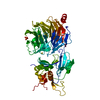 5cvlS  5cvnS C: citing same article ( S: Starting model for refinement |
|---|---|
| Similar structure data |
- Links
Links
- Assembly
Assembly
| Deposited unit | 
| |||||||||||||||||||||||||||||||||||||||||||||||||||||||||||||||||||||||||||||||||||||||||||
|---|---|---|---|---|---|---|---|---|---|---|---|---|---|---|---|---|---|---|---|---|---|---|---|---|---|---|---|---|---|---|---|---|---|---|---|---|---|---|---|---|---|---|---|---|---|---|---|---|---|---|---|---|---|---|---|---|---|---|---|---|---|---|---|---|---|---|---|---|---|---|---|---|---|---|---|---|---|---|---|---|---|---|---|---|---|---|---|---|---|---|---|---|
| 1 | 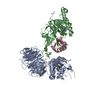
| |||||||||||||||||||||||||||||||||||||||||||||||||||||||||||||||||||||||||||||||||||||||||||
| 2 | 
| |||||||||||||||||||||||||||||||||||||||||||||||||||||||||||||||||||||||||||||||||||||||||||
| Unit cell |
| |||||||||||||||||||||||||||||||||||||||||||||||||||||||||||||||||||||||||||||||||||||||||||
| Noncrystallographic symmetry (NCS) | NCS domain:
NCS domain segments:
|
 Movie
Movie Controller
Controller




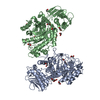

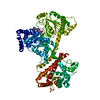
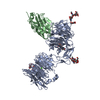
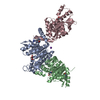
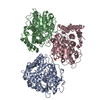

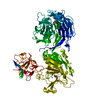
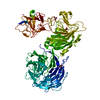
 PDBj
PDBj















